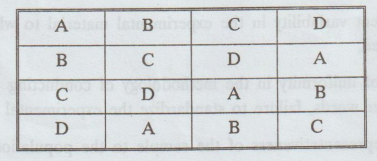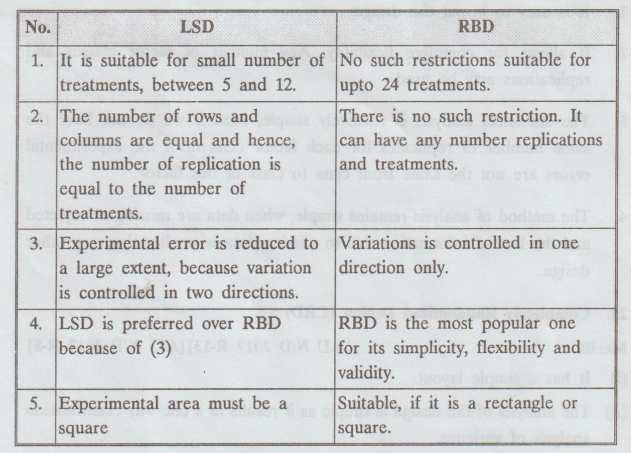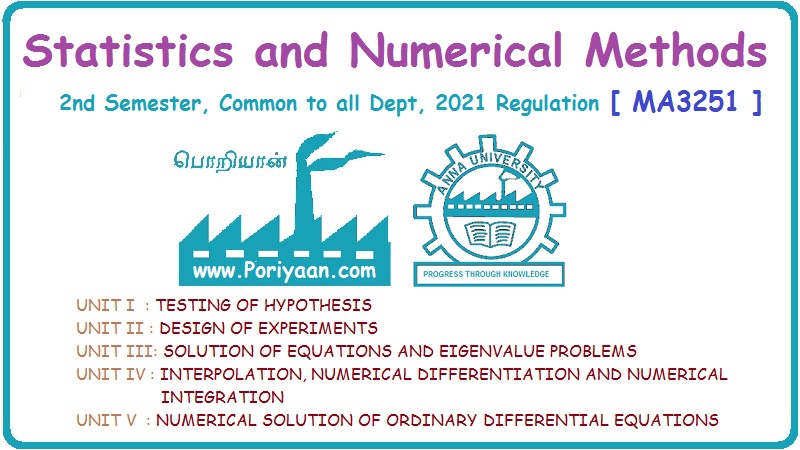Statistics and Numerical Methods: Unit II: Design of Experiments
Two Marks Questions with Answers
Design of Experiments | Statistics
Statistics and Numerical Methods : Unit - II : Design of Experiments : '2' Marks Questions and Answers
UNIT – II
DESIGN OF EXPERIMENTS
'2' MARKS QUESTIONS AND ANSWERS
1.
Define "Analysis of Variance." (or) ANOVA.
According
to R.A. Fisher, Analysis of variance (ANOVA) is the 'separation of variance
ascribable to one group of causes from the variance ascribable to other
groups'.
2.
The basic purpose of the analysis of variance is to test the homogeneity of .......
[A.U
A/M 2019 R-17]
[Ans.
several means.]
3.
Define "experimental error". [A.U N/D 2016 R-13]
The
estimation of the amount of variation due to each of the independent factors
separately and then, comparing these estimates due to assignable factors with
the estimate due to the chance factor is known as experimental error or simple
error.
4.
Write down the Assumptions in Analysis of variance.
1.
Normality, 2. Homogeneity, 3. Independence of error.
5.
Explain the word 'treatment' in analysis of variance.
The
word treatment in analysis of variance is used to refer to any factor in the
experiment that is controlled at different levels or values.
6.
What are the uses of analysis of variance? [A.U A/M 2017 R13]
1.
To test the homogeneity of several means.
2.
The ANOVA technique is now frequently applied in testing the linearit of the
fitted regression line or the significance of the correlation ratio ƞ.
7.
What do you mean by one-way classification in analysis of variance?
In
one-way classification the datas are classified according to only one AVOMA
criterion (or) factor.
8.
What do you mean by two-way classification in analysis of variance?
In
a two-way classification the datas are classified according to two different
criteria or factors.
9.
Define Mean sum of squares. [A.U N/D 2011]
Mean
Sum of Squares (M.S.S). The sum of square divided by its
degrees of freedom gives the corresponding variance or the mean sum of squares
(M.S.S.). Thus,

10.
Explain the term "Normality".
The
values in each group are normally distributed.
11.
Explain the term "Homogeneity".
The
variance within each group should be equal for all groups (σ21
= σ22 .... = σ2c ). This assumption
is needed in order to combine or pool the variances within the groups into a
single within groups' source of variation.
12.
Explain the term Independence of error.
It
states that the error (variation of each value around its own group mean)
should be independent for each value.
13.
Discuss the advantages of the two-way classification method over one-way
classification, if any. no ni noted brow [A.U N/D 2011]
1.
In two-way classification method, we can test two sets of hypothesis with the
same data at the same time but in one-way classification method, we cannot test
two sets of hypothesis.
2.
In a one-way classification method of analysis of variance, the treatments
constitute different levels of a single factor which is controlled in the
experiment. There are however, many situations in which the response variable
of interest may be affected by more than one factor. That is solved by two way
classification method of a time.
14.
What is ANOVA ? [A.U N/D 2016 R-13]
The
technique of analysis of variance is referred to as ANOVA. A table showing the
source of variation, the sum of squares, the degrees of freedom, mean squares
(variance) and the formula for F-ratio is known as ANOVA table.
15.
Explain the meaning and use of analysis of variance.
Analysis
of variance to test the homogeneity several means.
Uses
1.
It helps to find out the F-test.
2.
Between the samples, we can find the variances.
16.
What are the assumptions involved in ANOVA ?
Solution:
[A.U A/M 2010] [A.U N/D 2019 R-17]
1.
The samples are drawn from normal populations.
2.
The variances for the population from which samples have been drawn are
equal.oads on
om103
3.
The variation of each value around its own grant mean should be anom
independent for each value.
17.
Write the basic steps in ANOVA. [A.U Trichy N/D 2010]
Solution
:
1.
One
estimate of the population variance from the variance among the sample means.
2.
Determine a second estimate of the population variance from the variance within
the sample.
3.
Compare these two estimates, if they are approximately equal in value, a)
accept the null hypothesis.
18.
What are the Basic principles in the design of experiment ? do ad [A.U A/M 2015
R-13, M/J 2016 R-13] [A.U A/M 2017 R-13] [A.U A/M 2019 (R-17), N/D 2019 (R-13),
N/D 2021 (R-17)]
There
are three basic principles of experimental design.
They
are: (1) Randomization, (2) Replication, (3) Local control (error control)
19.
Construct 4 × 4 Latin square design. [A.U CBT
M/J 2010]
Solution:
Each
symbol appears one and only once in each row and column.

20.
What do you understand by "Design of an experiment" ? nisiq [A.U. M/J
2013] [A.U A/M 2015 R-13] [A.U N/D 2017 R-13]
The
design of an experiment may be defined as "the logical construction of the
experiment in which the degree of uncertainty with which the inference is drawn
may be well defined.
21.
Explain the purpose of design of experiments, and indicate the characteristics
of a good experimental design.
An
experiment is a device or a means of getting an answer to the problem under
consideration. Experiment can be classified into two categories as follows: (a)
Absolute and (b) Comparative.
Absolute
experiments consists in determining the absolute value of some characteristic
like (i) obtaining the average intelligence quotient (I.Q) of a group of
people, (ii) finding the correlation coefficient between two variables in a
bivariate distribution etc. On the other hand comparative experiments are
designed to compare the effect of two or more objects on some population
characteristic, (e.g.,) comparison of different manures or fertilizers,
different kinds of varieties of a crop, different cultivation processes,
different pieces of land in a field experiment, or different diets or medicines
in a dietary or medical experiment respectively, etc.
22.
Define Experimental Error, what are its main sources? What methods are adopted
to increase the accuracy of an experiment?
Experimental
Error. Suppose, a large homogeneous field is divided into
different plots (of equal shape and size) and different treatments are applied
to these plots if the yields from some of the treatments are more than those of
the others, the experimentor is faced with the problem of deciding whether the
observed differences are really due to treatment effects or they are due to
chance (uncontrolled) factors. In field experimentation, it is a common
experience that the fertility gradient of the soil does not follow any
systematic pattern but behaves in an erratic fashion. Experience tells us that
even if the same treatment is used on all the plots, the yields would still
vary due to the differences in soil fertility. Such variation from plot to
plot, which is due to random (or chance or non-assignable) factors beyond human
control, is spoken an experimental error.
Main
Sources are :
(i)
the inherent variability in the experimental material to which treatments are
applied,
(ii)
the lack of uniformity in the methodology of conducting the experiment or in
other words, failure to standardize the experimental technique, and
(iii)
lack of representativeness of the sample to the population under study.
The
following methods are adopted to increase the accuracy of an experiment. 1.
replication, 2. local control.
23.
What are the advantages of the Latin square design over other designs. [A.U
Tvli M/J 2011] [A.U A/M 2015 R-8]
The
advantages of the Latin Square design over other designs are:
(i)
With a two-way stratification or grouping, the Latin Square controls more of
the variation than the completely randomized design or the randomized block
design. The two-way elimination of variation often results in small
(ii)
The analysis is simple, it is only slightly more complicated than that for the randomized complete block design.
(iii)
The analysis remains relatively simple even with missing data. Analytical
procedures are available for omitting one or more treatments, rows, or columns.
However,
the number of treatments is limited to the number of rows and columns - except
in some situations. For more than ten treatments, the Latin square is seldom
used.
24.
What are the advantages of a completely Randomized Experimental design? [A.U
N/D 2011] [A.U A/M 2019 R-13]
The
following are the main advantages of this type of design :
1.
It is easy to layout the design.
2.
It allows for complete flexibility. Any number of factor classes and
replications may be used.
3.
The statistical analysis is relatively simple, even if we do not have the same
number of replicates for each factor class or if the experimental errors are
not the same from class to class of this factor.
4.
The method of analysis remains simple, when data are missing or rejected and
the loss of information due to missing data is smaller than any other design.
25.
Completely Randomized Design (CRD) : [A.U N/D 2017 R-13]
[A.U N/D 2017 R-8]
Merits:
(i)
It has a simple layout.
(ii)
The analysis of the design is simple as it results in a one-way classification analysis
of variance.
(iii)
There is complete flexibility as the number of replication is not fixed.
(iv)
Analysis can be performed, if some observation are missing.
Demerits
The
experimental error is large as compared to the other designs because
homogeneity of the units is not taken into consideration.
26.
Why a 2 × 2 Latin square is not-possible? Explain.
[AU
2006] [A.U A/M 2015 R-8, N/D 2015 R-13, M/J 2016 R-13] [A.U N/D 2019 R-13]
Consider,
a n × n Latin square design, then the degrees of freedom for SSE is
=
(n2 -1) - (n - 1) (n - 1) (n -
1)
=
n2 - 1 - 3n + 3
=
n2 - 3n + 2
=
(n-1) (n-2)
For
n = 2, d.f of SSE = 0 and hence, MSE is not defined.
comparisons
are not possible. Hence, a 2 × 2 Latin Square Design is not possible.
27.
Compare and contrast LSD and RBD. [AU 2003, A.U CBT N/D
2011, A.U. M/J 2013]

28.
What is the main aim of design of experiments?
[A.U N/D 2019 R-17]
Solution
:
The
main aim of design of experiment is to control the extraneous variables and to
minimize the error so that the results of experiments could be attributed to
the experimental variables only.
29.
Define a treatment and a yield in an experimental design. [A.U N/D 2020, A/M
2021]
Treatment:
The word treatment in analysis of variance is used to refer to any factor in
the experiment that is controlled at different levels or values.
Yield:
The measurement of a specific variable on different experimental units for
example different patients in a hospital in a medical experiment is called
yield.
30.
What is contrast and orthogonal contrast in a 22-factorial design? [A.U N/D
2020, A/M 2021 (R-17)]
Solution
:
Contrast
is a linear combination of treatment means, such that the sum of the
co-efficients is zero.
The
contrasts are orthogonal if the sum of product of co-efficients of corresponding
treatment means is zero.
31.
State the basic designs of experiment. [A.U N/D 2021 (R-17)]
Solution
:
1.
Completely Randomised Design (CRD)
2.
Randomized Block Design [RBD]
3.
Latin Square Desgin [LSD]
Statistics and Numerical Methods: Unit II: Design of Experiments : Tag: : Design of Experiments | Statistics - Two Marks Questions with Answers
Related Topics
Related Subjects
Statistics and Numerical Methods
MA3251 2nd Semester 2021 Regulation M2 Engineering Mathematics 2 | 2nd Semester Common to all Dept 2021 Regulation
